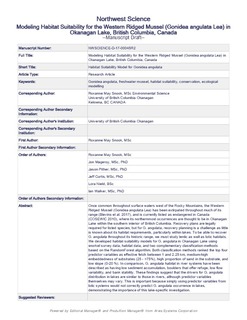| dc.contributor.author | Snook, M. Roxanne | |
| dc.contributor.author | Magerøy, Jon Hamner | |
| dc.contributor.author | Pither, Jason | |
| dc.contributor.author | Curtis, Jeff | |
| dc.contributor.author | Nield, Lora | |
| dc.contributor.author | Walker, Ian R. | |
| dc.coverage.spatial | Rocky Mountains, Canada | nb_NO |
| dc.date.accessioned | 2019-08-08T10:51:18Z | |
| dc.date.available | 2019-08-08T10:51:18Z | |
| dc.date.created | 2019-05-03T10:12:10Z | |
| dc.date.issued | 2019 | |
| dc.identifier.citation | Northwest science. 2019, 92 (5), 375-387. | nb_NO |
| dc.identifier.issn | 0029-344X | |
| dc.identifier.uri | http://hdl.handle.net/11250/2607581 | |
| dc.description.abstract | Once common throughout surface waters west of the Rocky Mountains, the western ridged mussel (Gonidea angulata Lea) has been extirpated throughout much of its range (Blevins et al. 2017). This species is currently listed as endangered in Canada (COSEWIC 2010), where its northernmost occurrences are thought to be in Okanagan Lake within the southern interior of British Columbia. Recovery plans are legally required for listed species; but for G. angulata, recovery planning is a challenge as little is known about its habitat requirements, particularly within lakes. To be able to recover G. angulata throughout its historic range, we must study lentic as well as lotic habitats. We developed habitat suitability models for G. angulata in Okanagan Lake using snorkel survey data, habitat data, and two complementary classification methods based on the RandomForest algorithm. Both classification methods ranked the top four predictor variables as effective fetch between 1 and 2.25 km, medium-high embeddedness of substrates (25 to > 75%), high proportion of sand in the substrate, and low slope (0–20%). In comparison, G. angulata habitat in river systems have been described as having low sediment accumulation, boulders that offer refuge, low flow variability, and bank stability. These findings suggest that the drivers for G. angulata distribution in lakes are similar to those in rivers, although predictor variables themselves may vary. This is important because simply using predictor variables from lotic systems would not correctly predict G. angulata occurrence in lakes, demonstrating the importance of this lake-specific investigation. Gonidea angulata, freshwater mussel, habitat suitability, conservation, ecological modelling | nb_NO |
| dc.language.iso | eng | nb_NO |
| dc.subject | Gonidea angulata | nb_NO |
| dc.subject | freshwater mussel | nb_NO |
| dc.subject | habitat suitability | nb_NO |
| dc.subject | conservation | nb_NO |
| dc.subject | ecological modelling | nb_NO |
| dc.title | Modeling Habitat Suitability for the Western Ridged Mussel (Gonidea angulata Lea) in Okanagan Lake, British Columbia, Canada | nb_NO |
| dc.type | Journal article | nb_NO |
| dc.type | Peer reviewed | nb_NO |
| dc.description.version | acceptedVersion | nb_NO |
| dc.rights.holder | © 2019 by the Northwest Scientific Association. All rights reserved. | nb_NO |
| dc.subject.nsi | VDP::Zoologiske og botaniske fag: 480 | nb_NO |
| dc.subject.nsi | VDP::Zoology and botany: 480 | nb_NO |
| dc.source.pagenumber | 375-387 | nb_NO |
| dc.source.volume | 92 | nb_NO |
| dc.source.journal | Northwest science | nb_NO |
| dc.source.issue | 5 | nb_NO |
| dc.identifier.doi | 10.3955/046.092.0508 | |
| dc.identifier.cristin | 1695342 | |
| dc.relation.project | Egen institusjon: University of British Columbia | nb_NO |
| dc.relation.project | Andre: Land, Natural Resource Operations, and Rural Development, Ca | nb_NO |
| dc.relation.project | Andre: BC Ministry of Forests, Canada | nb_NO |
| dc.relation.project | Andre: Pacific Northwest Shell Club | nb_NO |
| cristin.unitcode | 7511,6,0,0 | |
| cristin.unitname | Oslo | |
| cristin.ispublished | true | |
| cristin.fulltext | postprint | |
| cristin.qualitycode | 1 | |
